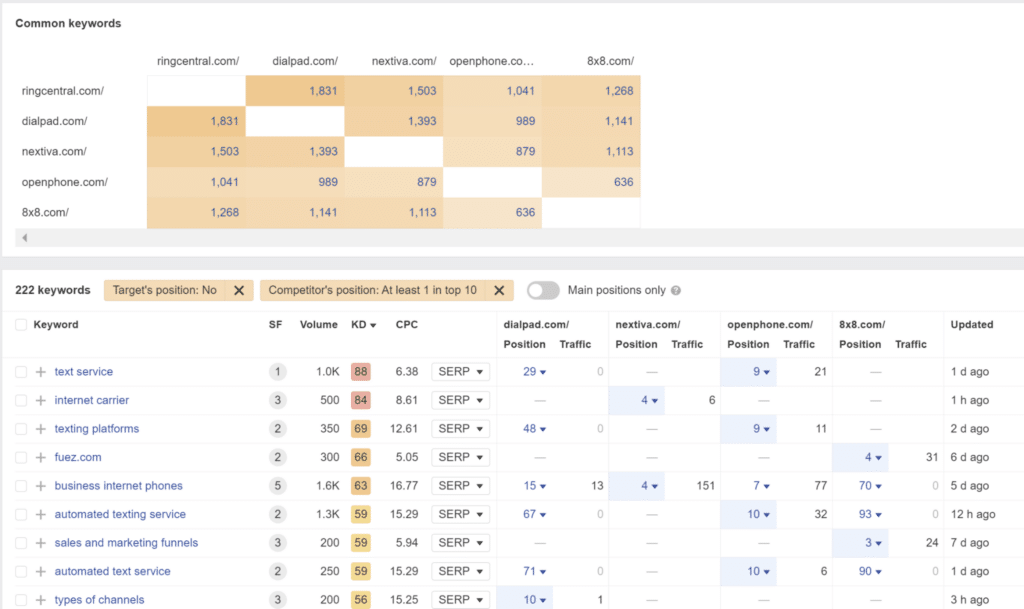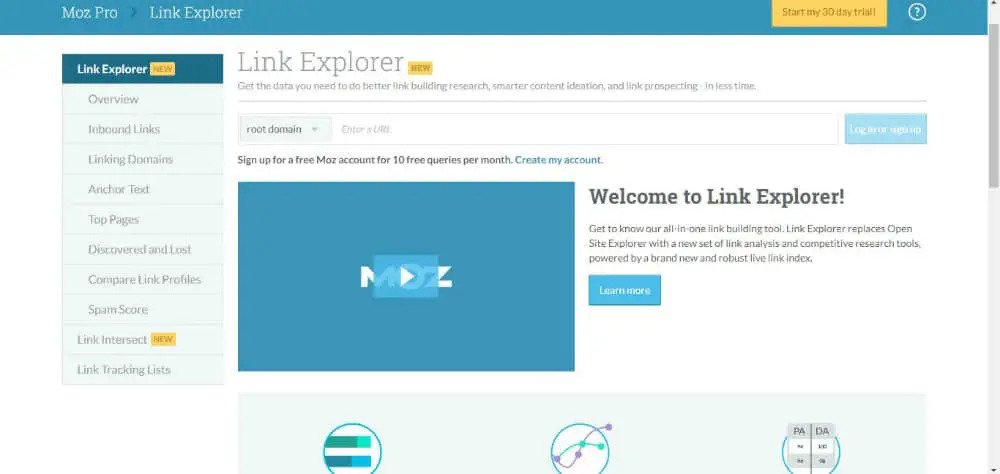SaaS SEO Guide
Performing a successful SaaS SEO competitor analysis
Book a FREE SEO Strategy Consultation >
Further Reading:
- SaaS SEO Strategy
- SaaS SEO Checklist
- SaaS Technical SEO
- SaaS SEO Audit
- SaaS Keyword Research
- SaaS SEO Content
- SaaS SEO Copywriting
- E-A-T for SaaS
- Enterprise SaaS SEO
- SaaS SEO Metrics and KPI's
- SaaS SEO Attribution
- VOIP and Telecommunications SEO Strategy
- SaaS Link Building
- Payroll and Finance SaaS SEO
- SaaS SEO Agency
- SaaS Link Building Agency
Stealing is wrong. That’s a moral absolute. Taking your competitor’s strengths and weaknesses and using them to improve your own performance is just good business. Every company in any field should always keep a close eye on what their main rivals are doing. That’s the basis for SaaS SEO competitor analysis.
Competition is a healthy part of business. Monitoring and trying to better your direct competitors is what keeps firms sharp. It encourages innovation, prevents complacency and offers inspiration to improve. SEO competitor analysis is how you achieve that kind of one-upmanship in the area of web traffic and SERP ratings.
When a business or website embarks on an SEO strategy, competitor analysis is far too often overlooked. Companies jump straight to researching keywords, seeking out links and creating their content. By doing so, they’re skipping over what is a key aspect of truly efficient SEO.
Book a Consultation
It is only by completing SEO competitor research that a firm gets a proper idea of where they stand in their field. That understanding of their position is what can then tell them where they should be aiming and what they can do to get there.
Real competitive intelligence about your rivals improves all aspects of SEO. It lets you know who you ought to be looking to outrank on SERPs. It shows you the keywords for which you should be ranking and where you can go to look for SaaS backlinks. Above all else, it also shows your own SEO strengths and weaknesses as well as those of your SEO competitors.
That’s why we’ve created this guide to good SEO competitor analysis. We’re going to talk about the process in depth and tell you everything you need to know. That will include how to do competitor analysis but starts with exactly why it’s important to do so.
Why SaaS SEO competitor analysis is important
In SEO as in life, the mantra of “keep your friends close but your enemies closer” remains valid. It is only by knowing your enemies that you can hope to consistently beat them.
SEO competitive analysis is the process by which you can get all the details you need about your rivals. It will provide you with data about which SEO tactics are working for those rivals. As you’re in the same field, it’s likely that those tactics could also work for you.
The competitive intelligence you get from proper analysis will also help you to identify your own areas of weakness. Those will be the places where your competitors are outdoing you. Recognizing that gives you a roadmap for how to improve your SaaS SEO strategy.
Good analysis of your competitors’ SEO can also reveal lots of things about SEO in your niche more generally.
It will reveal important keywords in your field. It will also let you know how competitive each of those are. You can then assess if there will be a good ROI if you choose to try and compete for them. Worthwhile backlink strategies will also become clear, as will domains from which you can try to get useful links.
For all of those reasons and more, SEO competition analysis is key to any overall SEO strategy. That’s why you will want to know everything there is to know about performing it effectively.
SaaS SEO competitor analysis checklist
When you start to define an overall SEO strategy, it helps to develop a SaaS SEO checklist to help you recognize and keep up with everything you need to consider. You can repeat this process at a more granular level, too, for each of the principal aspects of SEO.
Here’s a basic checklist to help you get the best competitive SEO insights:
- Identify competitors: Make a list of your main competitors.
- Keyword research: Identify the keywords and phrases your competitors are targeting.
- Organic search rankings: Determine your SEO competitors’ rankings for the identified keywords.
- Backlink analysis: Analyze the backlink profiles of your competitors to identify their sources of high-quality backlinks.
- Content analysis: Evaluate the content strategy of your competitors. Examine the types of content they produce (blog posts, case studies, tutorials, whitepapers, etc.). Assess the quality, length, and relevance of their content.
- On-page SEO analysis: Review the on-page optimization elements of your competitors’ websites, including meta tags, headings, URL structures, and keyword usage.
- User experience analysis: Evaluate the user experience of your competitors’ websites, focusing on factors like site speed, mobile-friendliness, navigation, and overall design.
- Social media presence: Analyze your competitors’ social media profiles and activities. Identify which platforms they’re active on, their follower count, engagement levels, and the type of content they share.
- Online reputation: Monitor your competitors’ online reputation by checking customer reviews, testimonials, and ratings on various platforms.
- Industry influence: Determine your competitors’ influence within your particular niche. Analyze their thought leadership content, guest blogging, speaking engagements, or participation in industry events.
- SWOT analysis: Based on the information gathered, conduct a SWOT analysis (Strengths, Weaknesses, Opportunities, Threats) for each competitor to identify their advantages and disadvantages in relation to your business.
- Actionable insights: Based on the analysis, develop an SEO competitor report to use to improve your SaaS SEO efforts. Focus on areas where you can outperform your competitors, address any weaknesses, and capitalize on opportunities.
How to do a SaaS competitor analysis in SEO
Now you’ve got your basic SaaS SEO competitor analysis checklist, you can get into the nuts and bolts of how to undertake competitor analysis in SEO.
The exact process of SEO competitor analysis can and should differ from one company to another. Your individual niche, your target customers, and your overall business goals will all have an impact on the shape of the process.
There are some general areas of, or steps toward, a good analysis which will apply to all firms and sites. It is these different areas which we’re going to provide an in-depth rundown of below. This is not a step-by-step guide but rather a collection of hints and tips.
Taking what you will from our advice should help you get the competitive intelligence you need to blow your rivals out of the water. To begin the process, however, you need to first know exactly who those rivals are.
Identifying your competitors
To perform SEO competitor analysis, you need to know who your competitors are. That may sound obvious but identifying your SEO rivals is perhaps not quite as straightforward as it sounds.
You probably have a pretty good idea of who your direct business competitors are. You spend all of your time trying to better their products and poach their customers. These firms will likely be amongst your SEO competitors, but they won’t be alone.
Your SEO competitors can come from anywhere and everywhere. It isn’t only firms in your own niche who might be your rivals in the world of SEO. Any site or page ranking for a keyword which you’re also targeting is a direct SEO competitor.
Say you’re a business communications company. You might have a blog on which you post articles about the latest telecoms or related tech. In an ideal world, you’d like those posts to rank for keywords like “VoIP phone systems”, “UCaaS”, “Conversational AI”, or similar.

Competition for those keywords will not come just from other business communications or even SaaS firms. You’d have to go up against high authority sites in related niches (like traditional telecoms) and tech magazine websites. You must know the keywords you want to target before you can start identifying your SEO competitors.
That means performing some keyword research. We go into some depth describing how to perform SaaS keyword research elsewhere, but let’s just refresh your memory.
To generate target keywords, you need to put yourself in the shoes of your customers. Building a customer persona is a good way to do this. It will help you work out the topics that your customers will be interested in. You will then be able to produce a list of possible head, body, and long tail keywords related to those topics.
Testing out the viability of those keywords can then be as simple as popping them into tools like Ahrefs or Semrush.
That will give you details like the search volume for each keyword and how competitive the keyword is. From there you can decide which keywords will deliver the best ROI. They are the ones that you should look to target.
Finding your SEO competitors becomes straightforward once you’ve identified those target keywords. Your first port of call should be the first SERP for each of your identified keywords.
The pages and companies listed there are your main competitors for those keywords. The pages ranked most highly on that first SERP are your biggest rivals. That means the pages in the top three positions or in the coveted “position zero” if there is one.
In case you don’t know what we mean by position zero, it’s the name given to the featured snippet at the top of some Google SERPS. Google started including those featured snippets back in 2014. They aim to display succinct answers to searchers’ questions.

Some snippets are quick answers or knowledge panels with little relation to SEO. Others use third-party information to provide an answer. They include the title and URL of the page from which the information is sourced. It is these snippets which are referred to as position zero. Getting a page or site into that position is like gold dust from an SEO point of view.
A quick glance at the SERPs for your keywords will show you the pages and domains you need to compete with. There are also some SEO competitor analysis software tools that you can use to make sure you get an accurate picture of your competition. SpyFu, for example, lets you input your domain or a target keyword and then produces a list of competing sites and pages.
Once you know who your competitors are, you can start analyzing the strengths and weaknesses of their SEO.
Competitor keyword analysis
Competitor keyword analysis is a crucial part of overall SEO competitor analysis. It can give you a whole host of vital data to inform your SEO strategy. There are three main elements to competitor keyword analysis:
- There is the analysis of the difficulty involved in challenging competitors to rank for different keywords.
- Identification of keywords that your rivals rank for, but you don’t. That is often known as Keyword Gap Analysis.
- There is then also the process of identifying useful keywords that both you and your competitors have overlooked. These keywords will be easier to rank for but may still deliver notable results when it comes to organic traffic. That makes them very interesting from an ROI point of view.
To look at the difficulty of ranking for particular keywords, you need to focus on your rivals’ pages. Specifically, those pages you identified earlier as ranking highly for the keyword in question. You will then want to analyze certain factors related to those pages.
The most important factors are things like page or domain authority, web traffic, and similar metrics. These are the ranking factors that Google will have accounted for in giving the pages their SERP rankings.
The easiest way to get that information is by using an SEO competitor analysis tool we’ve already mentioned; Ahrefs.

From the above, you can see some of the invaluable insights you can get in Ahrefs. Volume is displayed for common keywords and you can apply various different filters to work on what’s ranking and its value.
When trying to improve your SERP ranking for any keyword, you need to beat out the sites already ranking for it. Keyword gap analysis is a vital step in doing so. It is the process of identifying the keywords that high ranking pages rank for and you do not.
Tf-idf analysis is a great method for identifying those keywords. A tf-idf value reveals how frequently a keyword appears on a page, compared with how often it would generally be expected to appear. A higher value means that the page deals with the subject of the keyword more directly than most other pieces of content.
You can find a more in-depth analysis of tf-idf here. Our brief description, though, should have revealed its importance to competitor analysis. Performing tf-idf analysis on a competitor’s page gives you lots of great information.
It can reveal what keywords and subjects their content covers better than yours. It can also ID related keywords and niche topics that neither you nor your rivals cover well enough. That gives you a steer as to how you can improve your content to their level and beyond.
Backlink analysis
We all know that SEO isn’t only about keywords and SaaS SEO copywriting. Your SEO competitor analysis also needs to look at what your rivals are doing in different areas. To achieve a high SERP ranking, they will have built up an impressive backlink profile. You need to dig into that profile and learn lessons from it.
What is most valuable to learn is where your rivals are getting links from. There is no way to get this information manually, so you will once again want to lean on an SEO analysis tool. In this case, a free option is the Link Explorer tool from Moz.

Link Explorer lets you enter the URL of a root domain, subdomain, or exact page. It will then generate a huge amount of data related to the domain and its backlinks profile. You will see the domain’s inbound links, top pages, and linking domains, amongst other things.
You can also choose to compare the link profile of the domain with another. Choosing to compare it with your own, is how you can identify what your rival is doing differently to you in the area of backlinks.
This provides many options for you to tweak or adapt your own backlinks strategy. You may have found sites or domains that link to your rivals but not to you. You can then reach out to them and try to redress the balance.
You may also notice a different pattern to the inbound links of your rivals. They might tend toward links from different types of sites. Where you have lots of links from blogs, they might get theirs from ecommerce sites or other sources. If they’re ranking more highly than you, it might be a good idea to tweak your backlinks profile to more closely resemble theirs.
Content analysis
What we’ve covered so far in our guide to SEO competitor analysis are off-page factors. They are not the only things to look at. You will also want to look at your competitors’ pages and their content to evaluate on-page factors. We’re talking mostly about the discernible quality of that content.
There are lots of different things to consider when assessing content quality. You will want to think about how relevant content is to the site or company’s niche.
How well content meets reader intent is also important. Google is all about content being genuinely useful to readers and providing them with real answers to their questions. A good indicator of overall quality is how comprehensive your content is. Lengthy articles that really get to grips with a subject are better than short, vague pieces of content.
Don’t forget about the importance of E-A-T for SaaS SEO, either. Google will always favor content which is demonstrably expert, authoritative, and trustworthy.
This stage of your SEO competitor analysis requires more work on your part. You can’t use an SEO analysis tool to mine data. You need to read your competitors’ content and make a subjective assessment. You can then compare the quality of the content with your own. That will give you an idea of if and how your content needs to be improved.
User experience analysis
As well as rewarding high-quality, Google also views user experience as an important ranking factor. They tend to rate sites which are easier to navigate higher than others. They also like sites to be accessible to as many different users as possible. That means users on their phones, on tablets, laptops, and desktops.
When assessing competing pages and sites, you’ll also want to look at user experience. That means checking how mobile-friendly a rival site is. Since 2015, sites that aren’t mobile-friendly have been penalized by Google. Google also gives preference on SERPs to sites that load quickly.
Good competitor analysis will identify and assess how rival sites perform in these areas. If highly ranked competitors outdo you on user experience, that’s a definite area for you to improve. If their user experience isn’t top-notch but they still rank highly, it’s an area where you might make significant gains on them.

Social media & customer interaction analysis
The exact relationship between social media and SEO is somewhat shrouded in mystery. Google has stated that they do not treat shares on social media in the same way as links. It’s widely accepted that there is some correlation between social media presence and better SERP ranking.
That makes how your rivals use social media another important element to include in SEO competitor analysis. You’ll want to look at which platforms your competitors do and don’t use. It will also prove useful to note how often they share content and of what types. Whether they directly communicate with other social media users could also prove illuminating.
That information can help you to adjust and tweak your own social media usage. Even if the exact impact this has on SEO is uncertain, it can deliver other benefits. Following the lead of competitors who excel in social engagement can only help you to improve customer relationships.
Examples of SaaS SEO competitive research tools
Throughout our guide to SaaS SEO competitor analysis we’ve mentioned a number of different tools that can help you along the way. In case you’ve lost track, here’s a quick summary rundown of our suggestions:
- Ahrefs
- Semrush
- SpyFu
- Site Explorer from Cognitive SEO
- Moz Link Explorer
- Google Keyword Planner
Know your enemy with SaaS SEO competitor analysis
Only through healthy competition can businesses stay sharp and on top of their game. Looking to better your rivals is not a matter of ego. It’s how firms stay afloat and ensure they best serve their customers. You can only better your rivals if you understand exactly what it is that they’re doing.
In the case of SEO, the way you can get to know your enemy is by performing SEO competitor analysis. That process begins by correctly identifying your competition. It then covers everything from the keywords they target, to the links they’ve achieved, all the way to how they use social media.
Armed with all of that information, you can improve your own SaaS SEO. You’ll know how to improve your content and where to look for new links. You’ll also understand how to amend your site architecture and what other technical adjustments you might make.
Knowing your enemy is the key to improving your own SEO.